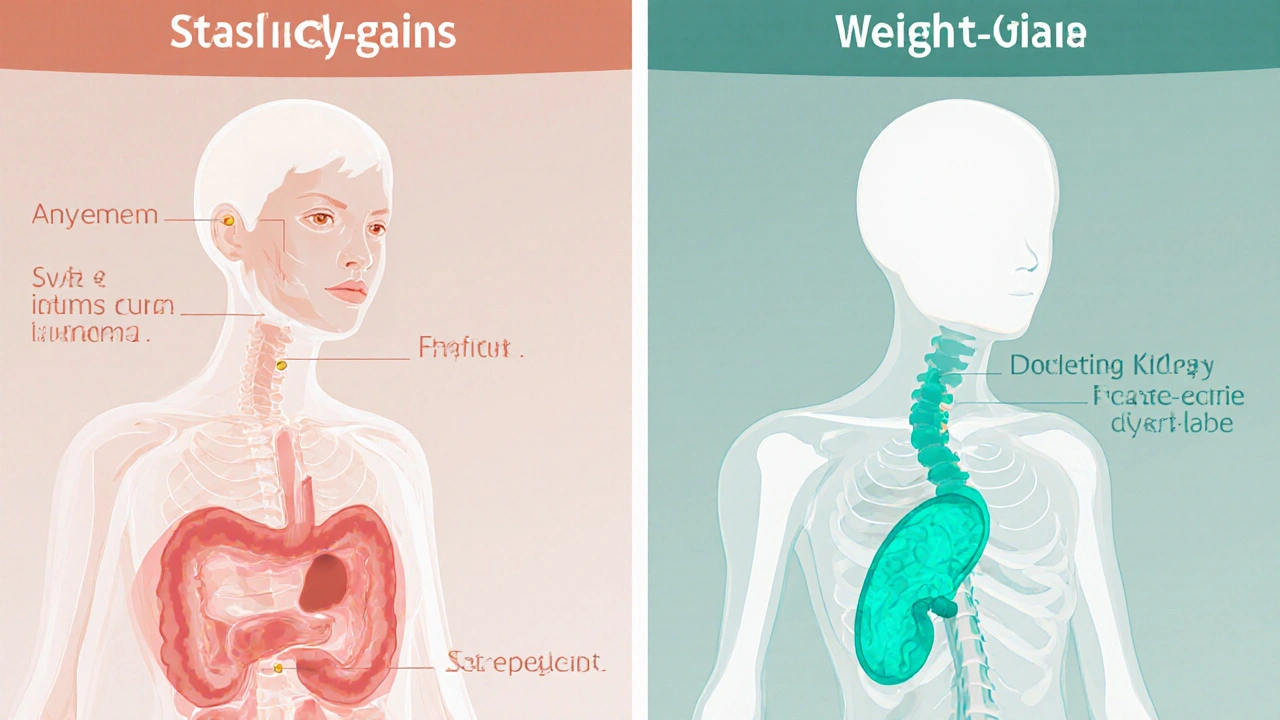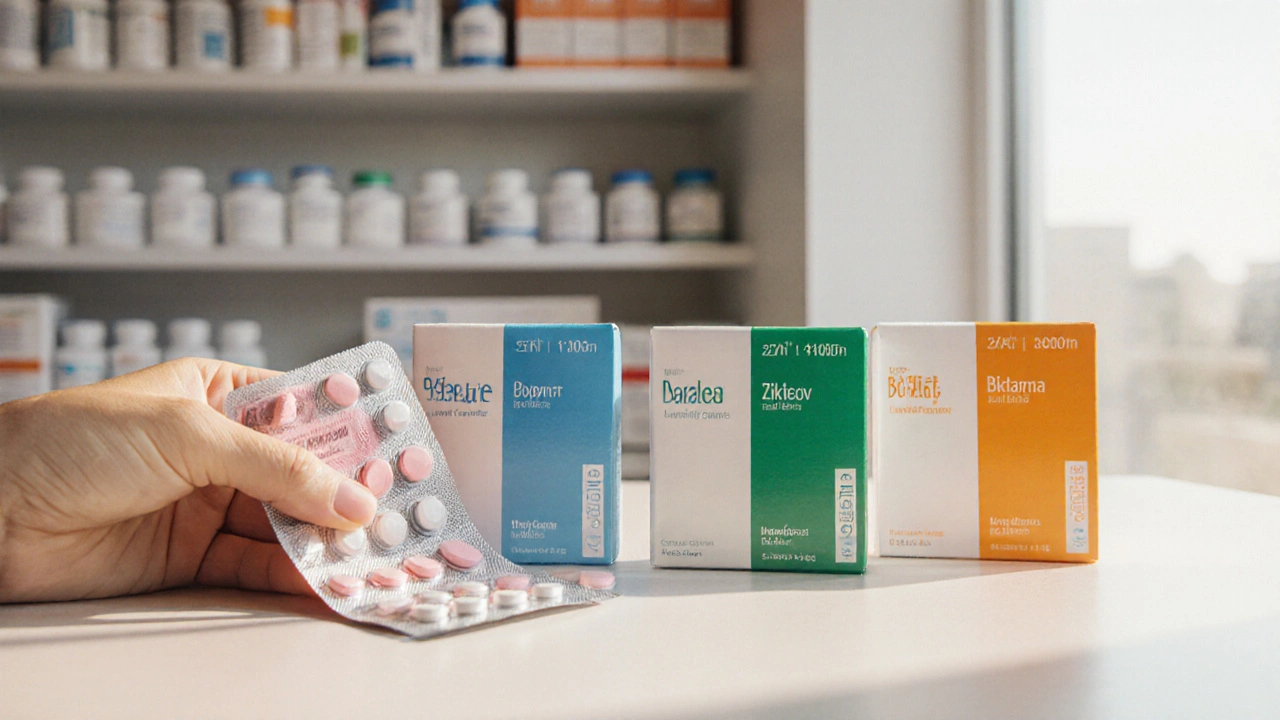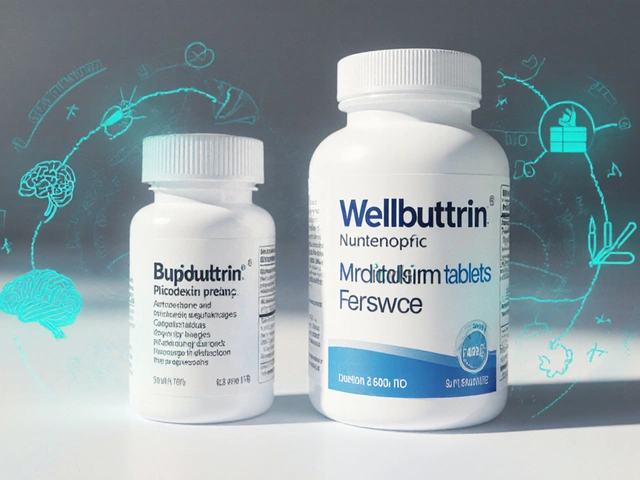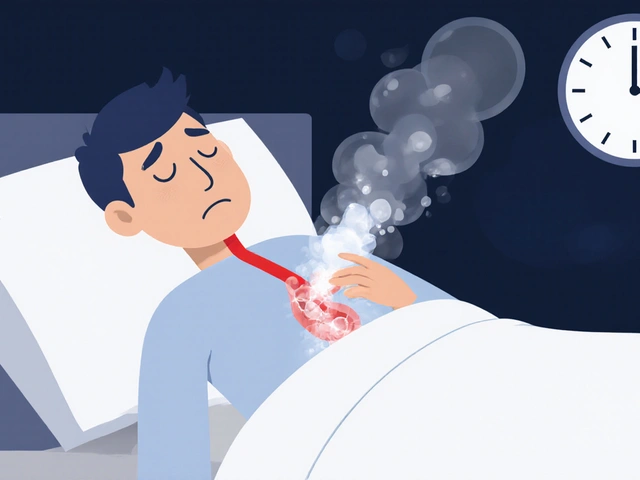Combivir vs. Modern HIV Regimens Comparison Tool
Use this interactive tool to compare key characteristics of Combivir and modern HIV regimens. Select a regimen to see detailed information.
Combivir
Lamivudine + Zidovudine
Anemia Neutropenia Low CostTruvada
Emtricitabine + Tenofovir DF
Kidney Issues Once DailyDescovy
Emtricitabine + Tenofovir AF
Lipid Changes Kidney FriendlyBiktarvy
Bictegravir + Emtricitabine + Tenofovir AF
Weight Gain High BarrierAtripla
Efavirenz + Emtricitabine + Tenofovir DF
Neuropsychiatric Once DailyWhen it comes to managing HIV, choosing the right antiretroviral regimen can feel overwhelming. Combivir is a fixed‑dose combination of Lamivudine and Zidovudine, approved in the mid‑1990s and still prescribed in many parts of the world. But newer options-like Truvada, Descovy, and Biktarvy-promise once‑daily dosing, lower toxicity, and higher barriers to resistance. This guide breaks down the key differences so you can decide which Combivir alternatives fit your health goals, lifestyle, and budget.
What Combivir Actually Is
Combivir delivers two nucleoside reverse transcriptase inhibitors (NRTIs) in one pill: 150mg of Lamivudine and 300mg of Zidovudine. The duo works by blocking the HIV reverse transcriptase enzyme, halting viral replication. Because both drugs have been on the market for decades, clinicians have a deep safety record, but they also come with well‑known side effects such as anemia, neutropenia, and gastrointestinal upset.
How Modern Alternatives Differ
Newer regimens combine NRTIs with either an integrase strand transfer inhibitor (INSTI) or a non‑nucleoside reverse transcriptase inhibitor (NNRTI). The most popular combos include:
- Truvada-Emtricitabine+Tenofovir disoproxil fumarate (TDF)
- Descovy-Emtricitabine+Tenofovir alafenamide (TAF)
- Biktarvy-Bictegravir+Emtricitabine+Tenofovir alafenamide
- Atripla-Efavirenz+Emtricitabine+Tenofovir disoproxil fumarate
Each of these pills is taken once a day, a convenience factor that directly improves adherence rates.
Side‑Effect Profile Comparison
| Regimen | Common Side‑Effects | Serious Risks | Monitoring Needed |
|---|---|---|---|
| Combivir | Nausea, headache, fatigue | Anemia, neutropenia, lactic acidosis (rare) | CBC every 3 months, liver enzymes |
| Truvada | Renal tubular dysfunction, mild GI upset | Kidney injury, bone mineral density loss | Renal function, DXA baseline if at risk |
| Descovy | Weight gain, mild insomnia | Less renal toxicity, but possible lipid elevation | Lipid panel annually |
| Biktarvy | Insomnia, dizziness | Potential weight gain, rare hypersensitivity | Weight and metabolic labs quarterly |
| Atripla | Vivid dreams, rash | Neuropsychiatric events, liver toxicity | Mental health screening, liver enzymes |

Resistance Barrier and Efficacy
Combivir’s two‑drug backbone offers a moderate barrier to resistance; mutations in the reverse transcriptase gene can compromise both Lamivudine and Zidovudine fairly quickly if viral suppression lapses. Newer regimens pair NRTIs with agents that have a high genetic barrier-like Insti‑drugs bictegravir (Biktarvy) or dolutegravir (often included in other combos). Clinical trials consistently show >95% viral suppression rates at week 48 for these newer combos, compared with 85‑90% for older dual NRTI regimens when used without a third active drug.
Cost Considerations (2025 US Prices)
Price is a decisive factor for many patients. Below are average wholesale acquisition costs (WAC) for a 30‑day supply:
- Combivir: ≈$210
- Truvada: ≈$1,500
- Descovy: ≈$1,800
- Biktarvy: ≈$2,200
- Atripla: ≈$1,250
Insurance formularies often place generic Lamivudine/Zidovudine at the lowest co‑pay tier, but many plans now favor newer fixed‑dose combos because of better adherence outcomes. Patient assistance programs exist for the pricier options.
Which Option Fits Which Patient?
Combivir is best for: patients who need a low‑cost regimen, have no issues with anemia, and can commit to twice‑daily dosing. It’s also a go‑to in resource‑limited settings where newer drugs aren’t yet approved.
Truvada or Descovy suit individuals who want once‑daily dosing and have stable kidney function. Descovy’s newer tenofovir alafenamide form reduces renal toxicity, making it a better choice for older adults.
Biktarvy is ideal for treatment‑naïve patients who want a single‑tablet, high‑barrier regimen and are comfortable with a slightly higher price tag.
Atripla remains an option for patients who cannot tolerate INSTI side‑effects but need an NNRTI backbone.

Practical Decision Checklist
- Do you have insurance coverage that favors generic combos? → Consider Combivir.
- Is renal function a concern? → Prefer Descovy over Truvada.
- Can you manage twice‑daily dosing? → If not, pick a once‑daily option.
- Are you newly diagnosed and want the highest resistance barrier? → Biktarvy or similar INSTI‑based regimen.
- Do you have a history of anemia or neutropenia? → Avoid Zidovudine‑based combos.
Next Steps for Patients and Clinicians
1. Review the latest CDC HIV treatment guidelines (2024 update) to confirm recommended first‑line regimens.
2. Run baseline labs: CBC, renal panel, lipid profile, and hepatitis B status.
3. Discuss lifestyle factors-diet, alcohol use, and potential drug‑drug interactions.
4. Choose a regimen that aligns with cost, dosing convenience, and tolerability.
5. Schedule follow‑up viral load testing at weeks 4, 12, and 24 to confirm suppression.
Frequently Asked Questions
Can I switch from Combivir to a newer regimen?
Yes. Switching is common once viral suppression is achieved. Your clinician will run a resistance test and adjust the new regimen based on your lab results and any comorbidities.
Is Combivir still recommended in 2025?
Guidelines list Combivir as an alternative for patients who cannot access newer drugs or need a low‑cost option. It’s not a preferred first‑line regimen for most treatment‑naïve individuals.
What are the main drug‑interaction concerns with Combivir?
Both Lamivudine and Zidovudine are cleared renally, so strong nephrotoxic agents (e.g., non‑steroidal anti‑inflammatory drugs at high dose) can raise plasma levels. Avoid concurrent use of other NRTIs without medical supervision.
How does Biktarvy’s resistance barrier compare to Combivir?
Biktarvy’s integrase inhibitor bictegravir has one of the highest genetic barriers among HIV drugs. In contrast, resistance to Zidovudine can develop after just a few weeks of sub‑optimal adherence.
Are there any dietary restrictions with these regimens?
None of the listed regimens require strict fasting. However, high‑fat meals can slightly delay absorption of tenofovir disoproxil fumarate (Truvada), so taking it with a light snack is often recommended.







When you stare at the price tag of Combivir you realize it's not just a medication, it's a metaphor for choosing between comfort and progress. The cheapness whispers safety, yet the modern pills scream liberation from twice‑daily shackles. I feel the tension between nostalgia for a regimen that once saved lives and the restless urge to embrace a single‑tablet future. It's a battle of heartbeats, where each dose is a pulse of hope or a reminder of compromise. We must ask ourselves: is affordability worth the trade‑off of anemia and neutropenia? The answer sits at the intersection of economics, biology, and personal dignity.
Great overview! I’d add that many clinics now offer tiered assistance programs for Truvada and Biktarvy, which can bring the monthly cost down to a fraction of the listed price. 😊 Also, patients with pre‑existing anemia should have baseline CBCs before starting Combivir. Monitoring is key!
Honestly, Combivir feels like the dinosaur of HIV therapy, completely outdated.
While the emotional pull of legacy drugs is understandable, the data clearly favors regimens with higher barriers to resistance. Switching to an INSTI‑based combo after viral suppression can reduce long‑term toxicity. It’s a pragmatic step, not a betrayal of the past.
okay so combivir is cheap but i cant stress enough how annoying that twice daily schedule is it messes with your routine especially if you work nights also the anemia thing is real you might feel fatigued all the time and that can affect your daily life you really should consider the newer options they cost more but the convenience and safety are worth it
Let’s not forget the shadowy lobbyists who keep pushing the pricey pills while claiming they’re the only “gold standard.” The pharma giants love to hide the fact that the older NRTI backbone is perfectly effective when paired with proper adherence. It’s a classic case of profit‑driven hype disguised as medical progress.
In the U.S. the guidelines have moved away from zidovudine combos, yet some doctors still cling to them out of habit. This habit is not just a medical error, it reflects a broader resistance to change that hurts patients.
Oh, the drama of choosing a pill! It’s like picking a costume for a party you’re not even invited to. If you’re stuck with Combivir, just remember you’re playing the role of a budget‑hero in a saga of side‑effects.
If you’re looking for a quick decision tree: start with kidney function – if it’s normal, Truvada or Descovy works; if you have renal concerns, go for Descovy or Biktarvy. For patients with anemia, avoid Zidovudine. Always check insurance formularies early to avoid surprise copays.
Wow, what a tangled web of options, each with its own cost, sideeffects, and dosing schedule, you’re really lucky to have such a variety, honestly, it’s a blessing, and a curse, because decision‑fatigue can set in, but with proper counseling you’ll land on the right choice, guaranteed!
The key points are cost, renal health, and dosing frequency.
Sure, because everyone loves paying extra for a single pill that might make them a little dizzy.
Combivir’s side‑effects are not something you can just brush off; anemia can be a real deal‑breaker for many patients.
Hey folks, just wanted to say that whatever you choose, keep an eye on your labs and stay in touch with your doc. Cheers!
Remember, you’re not alone in navigating this. Small steps, steady monitoring, and a supportive team make the journey easier.
Choosing an antiretroviral regimen is, in many ways, a microcosm of the broader healthcare decision‑making process that we as societies continually grapple with. It begins with the stark reality that not all patients have equal access to the most advanced pharmaceuticals, a fact that is underscored by the stark price differentials presented in the table above. When a patient, for instance, is confined to a modest budget, the temptation to select Combivir, with its relatively low cost, becomes almost inevitable. Yet the very affordability of Combivir carries hidden costs: twice‑daily dosing, a higher propensity for anemia, and a moderate barrier to resistance that can jeopardise long‑term viral suppression. In contrast, regimens such as Biktarvy, though substantially more expensive, offer a once‑daily single‑tablet solution, a very high resistance barrier, and a side‑effect profile that, while not without concerns, tends to be more manageable for many individuals. Moreover, the shift from tenofovir disoproxil fumarate (TDF) to tenofovir alafenamide (TAF) in drugs like Descovy reflects a broader trend toward reducing renal toxicity, an advancement that is especially pertinent for aging populations. Another layer of complexity is added by the necessity of routine monitoring; while all regimens require periodic viral load testing, the specific lab panels differ, with Combivir necessitating regular complete blood counts to watch for hematologic issues. The decision matrix, therefore, is not merely a matter of drug efficacy, but a nuanced interplay of pharmacoeconomics, patient lifestyle, comorbid conditions, and the healthcare infrastructure that supports ongoing follow‑up. Ultimately, the best regimen is the one that aligns with the patient’s clinical profile, financial reality, and personal preferences, while also being supported by a robust care team able to navigate the intricacies of side‑effect management and adherence reinforcement.
Oh sure, because we all love paying extra for a pill that only slightly reduces the chance of kidney issues. 🤷♂️
Imagine the saga of a patient torn between the austere, iron‑clad reliability of Combivir and the shimmering promise of a modern single‑tablet wonder – it's like choosing between a sturdy oak and a sleek glass skyscraper, each with its own hidden cracks and shining façades.
For patients with a history of anemia, it is advisable to avoid Zidovudine‑based regimens and consider alternatives with a higher safety margin.
I understand that navigating these choices can be overwhelming; please know that your healthcare team is here to support you through each step of the process.